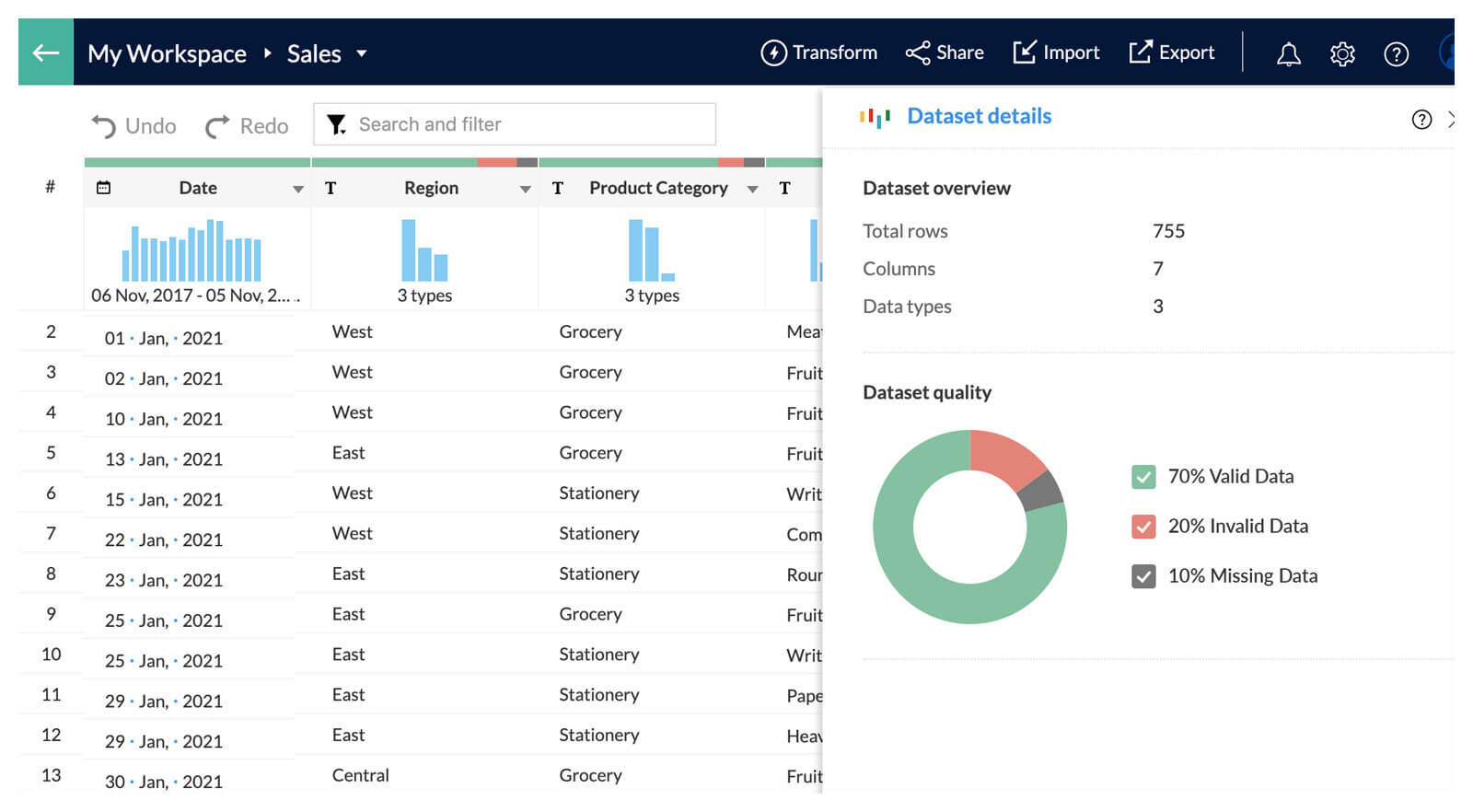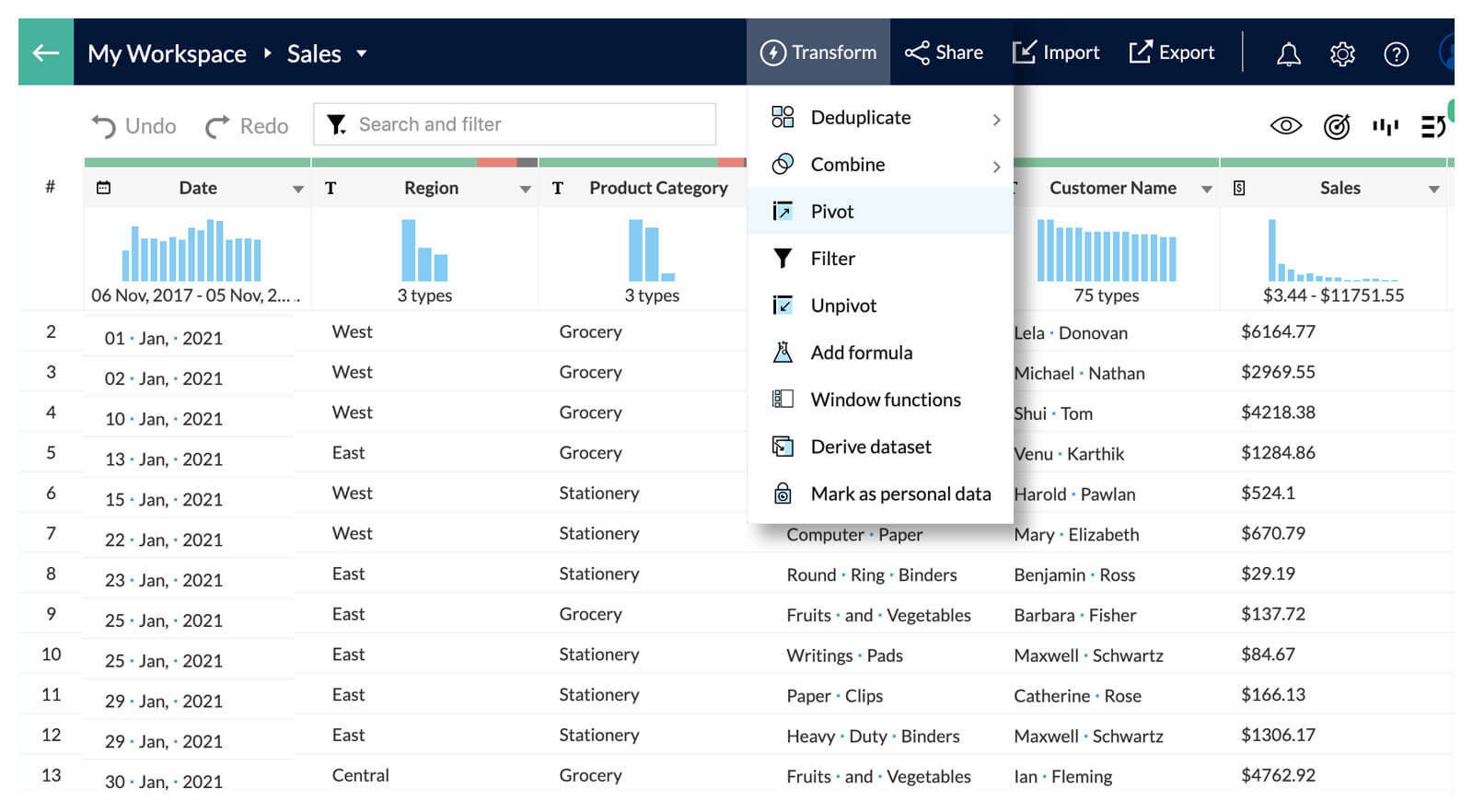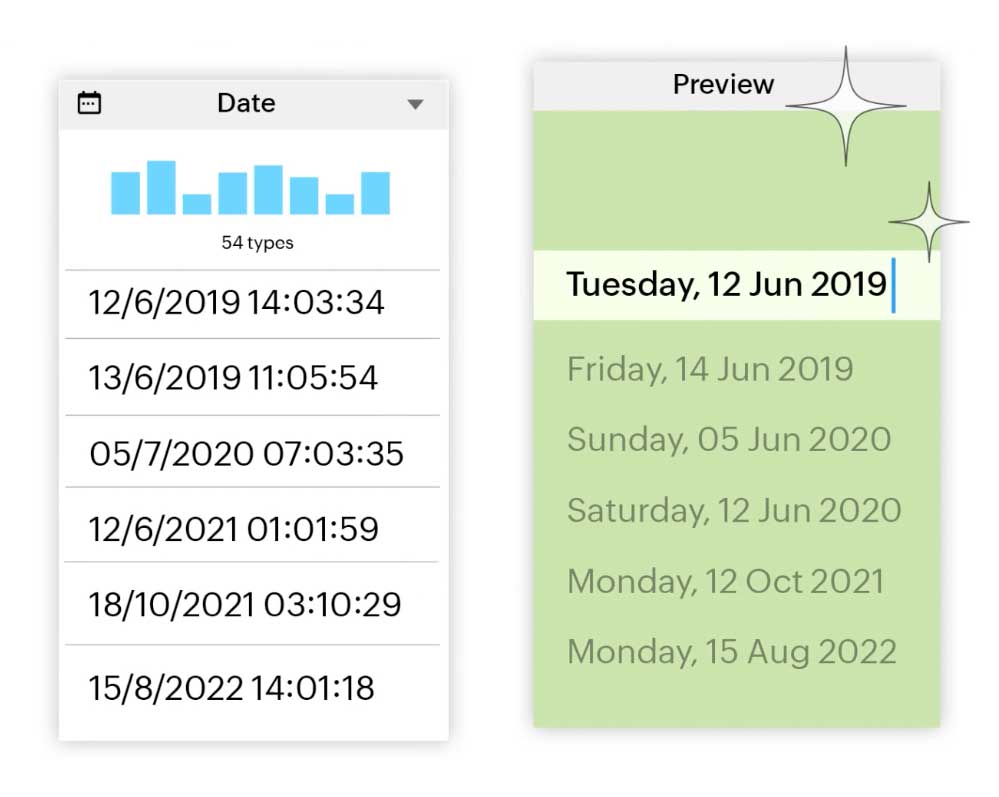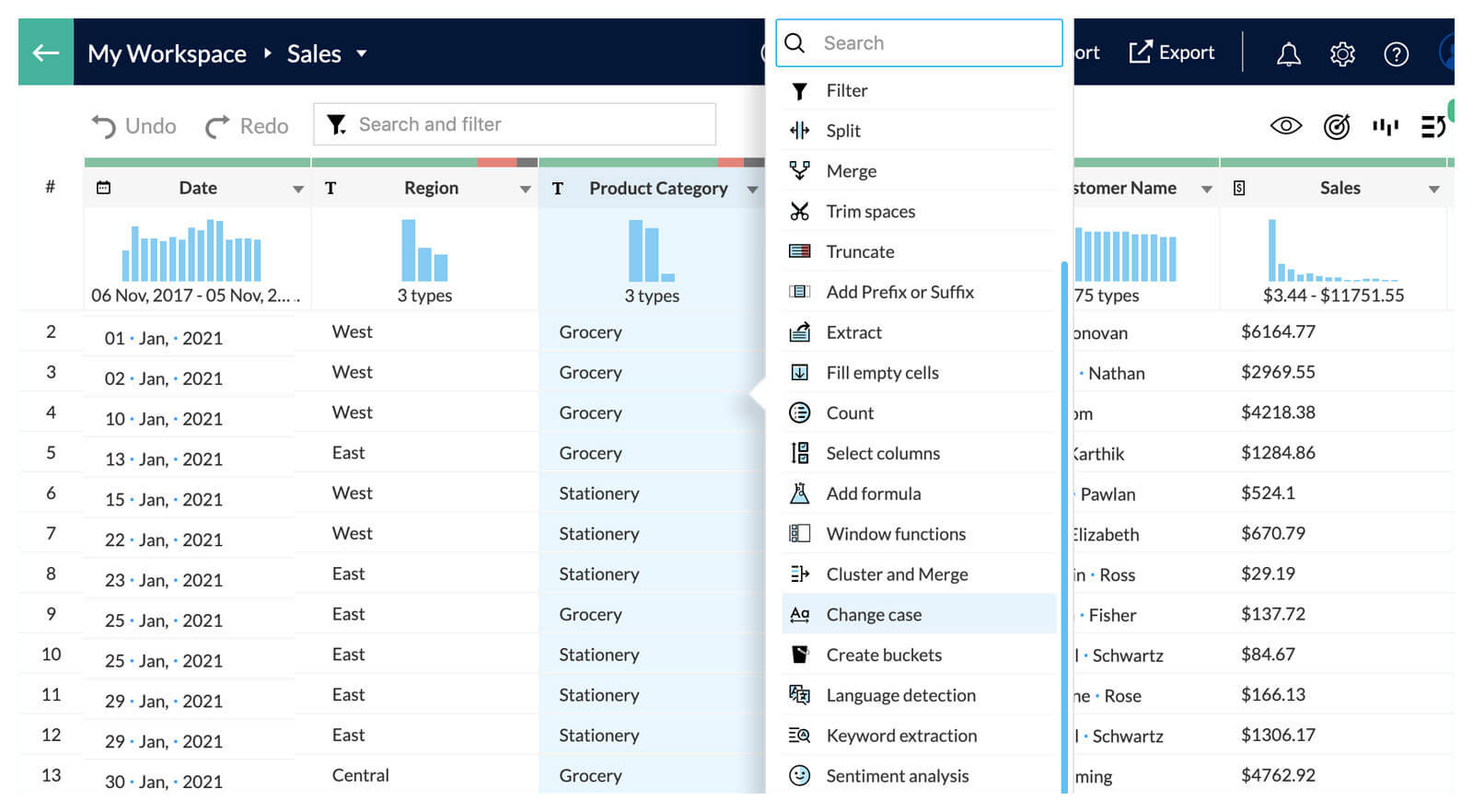What will I learn?
- What is data cleaning?
- Why is data cleaning important?
- Data cleaning vs data transformation. What is the difference?
- Data cleaning, data cleansing, and data scrubbing. Are they all the same?
- How to clean your data?
- Characteristics of clean data
- Common data quality issues
- Benefits of data cleaning
- Best practices for effective data cleaning
- Data cleaning tools
Data Cleaning: What It Is, How It Works, and how to
The quality of insights you derive depends directly on the quality of the data. You can perform accurate data analysis and make better decisions with high-quality data. However, raw data often lacks quality and is filled with errors, inconsistencies, and missing values.
So, what needs to be done when the data quality is poor? Data cleaning.
What is data cleaning?
Data cleaning is a process of detecting and correcting or removing inaccurate, incomplete, or incorrectly formatted data within a dataset. With data cleaning, you can transform raw data into high-quality, reliable data that is ready for analysis.
Here are the main objectives of data cleaning:
- Identifying incomplete, incorrect, inaccurate, irrelevant, duplicated, or improperly formatted data.
- Applying fixes like data correction, normalization, and handling missing values to address such issues.
- Improving data quality and making it consistent for effective analysis and applications.
- Transforming raw data into well-structured, clean master data for reporting, analytics, machine learning models, etc.
Why is data cleaning important?
Data cleaning is a crucial step in data analytics and data management. Low-quality data can distort analysis results and lead to incorrect conclusions. By cleaning the data, you can trust that the insights derived are based on reliable information.
Data cleaning is essential for ensuring the accuracy, reliability, and usability of data for analysis and decision-making. With data cleaning, organizations can get the full potential of data and gain a competitive edge.
Data cleaning vs data transformation. What is the difference?
Data cleaning focuses on identifying and fixing issues in the existing data by removing duplicates, fixing formatting, handling missing values, etc.
On the other hand, data transformation modifies the data structure or content through techniques like normalization, aggregation, concatenation, etc., to make the data suitable for specific purposes.
In essence, data cleaning prepares the data for transformation, and data transformation prepares the data for analysis.
Data cleaning, data cleansing, and data scrubbing. Are they all the same?
In practice, yes, these terms are often used interchangeably to refer to the process of improving data quality, and the specific terminology may vary depending on the industry, context, or even individual preferences.
Regardless of the term used, the goal remains the same: to improve the quality and reliability of the data for analysis.
How to clean your data?
Below are the common steps that can be followed to clean and prepare your data for analysis.
- Check data quality: Perform an initial analysis to understand quality issues like missing values, outliers, duplicates, etc. Generate summary statistics and metrics to quantify the extent of problems.
- Remove irrelevant data: Delete data that is not required for the analysis objective. Removing unnecessary attributes speeds up processing and minimizes storage needs.
- Deduplicate your data: Identify duplicate records in the dataset and decide which ones to keep or remove. This eliminates redundancies and inconsistencies arising from duplicate data.
- Transform data: Modify dataset structure, content, or representation to meet analysis requirements. Common transformations include data type conversions, normalization, clustering and merging, filling empty cells, etc.
- Transform by example: Intuitively specify desired data transformations through examples rather than complex scripts. Zoho DataPrep automatically applies the transformation example to the entire dataset or the specified column.
- Enrich your data: Enrich your data with ML/AI-powered transforms, such as adding prefixes or suffixes, trimming white spaces, splitting and merging, and more.
- AI-based enrichment: Enrich your data with AI-powered transforms such as sentiment analysis, keyword extraction, language detection, and more.
- Validate data: Examine the cleaned dataset to ensure desired results are achieved as per defined data quality goals and no new issues are introduced.




Characteristics of clean data
Here are the characteristics that are used to define data quality:
- Valid: Data is considered valid when it meets the defined criteria or rules for acceptance within a dataset.
Example: A valid customer email address should have the appropriate email syntax and domain information. - Accurate: Data is considered accurate when it is free from errors, discrepancies, or inaccuracies.
Example: A customer's shipping address should precisely match their actual shipping location. - Complete: Complete data contains all the necessary information required for analysis. It includes all relevant data points, attributes, or fields without any missing values.
Example: Customer records should include essential contact details like phone number, email address, etc. - Consistent: Consistent data maintains uniformity in structure, formats, and representations across the dataset. Maintaining data consistency requires enforcing data validation rules, standardizing data formats, and resolving any discrepancies or contradictions within the dataset.
- Uniform: Uniform data maintains consistent structure, presentation, or representation throughout the dataset. It facilitates seamless integration and interoperability across different systems or processes. Example: Phone numbers should be stored in the same format, such as 123-456-7890, across records and systems.
Common data quality issues
Real-world data is often imperfect, which impairs quality and leads to issues in analysis. Some common data quality issues are:
- Incomplete data
- Duplicate data
- Inaccurate data
- Inconsistent data
- Outdated data
- Noisy data
- Improper data formatting
Benefits of data cleaning
Performing data cleaning provides many benefits that make it a valuable investment for organizations. Here are some of the best benefits:
- Increased data accuracy: With data cleaning, you can identify and fix incorrect and inaccurate values, increasing the accuracy of data and making it more truthful.
- Improved data reliability: By cleaning and transforming incomplete and inconsistent data, the dataset becomes more stable, consistent, and trustworthy. Properly structured, validated data with fewer errors is more reliable for analysis.
- Better operational efficiency: Clean data allows organizations and teams relying on that data to function smoothly and efficiently. Data issues can cause process operation failures.
- Enhanced productivity: The time data analysts spend diagnosing data issues and planning workarounds can decrease, and they can spend their valuable time better deriving insights.
- Reduced costs: Investing in data cleaning is less expensive compared to solving problems caused by inaccurate data. So, it's always better to clean data at the start.
- Faster, more accurate reporting: Clean data ensures metrics and KPIs are calculated accurately without data errors. Clean data leads to faster and more reliable reporting.
- Strategic decision-making: Timely, high-quality data allows the leadership team to understand the situation better and make the right decision at the right time.
- Improved data governance: High-quality data helps organizations establish proper controls and data management policies effectively.
Best practices for effective data cleaning
To clean, enrich, and transform data, organizations can follow these best practices:
- Automate repetitive tasks: Automating repetitive data cleaning tasks through scripts, ETL workflows, or rule sets increases efficiency. This reduces repetitive manual work for data analysts and minimizes human errors.
- Track data lineage end-to-end: Understand the starting point and movement of data from source systems to downstream usage. This provides visibility into how errors may have been introduced during generation, processing, or storage.
- Monitor data quality routinely: Define data quality KPIs like accuracy % and complete or duplicate records, and track them over time. Periodic profiling and auditing identify new issues before they escalate.
- Collaborate cross-functionally: Work with business teams to understand data usage context. Collaborate with the engineering team to fix upstream quality issues through better system design.
- Follow standardized methodologies: Use consistent, repeatable data-cleaning approaches based on industry-standard frameworks. Uniform processes aid governance, auditing, and skill building.
- Maintain version control: Store iterations of cleaned datasets with parameter and code versioning for reproducibility. This also supports auditing data cleaning processes.
- Use specialized tools: Dedicated data preparation software provides scalable capabilities like standardization, expression-based transformations, etc., that are hard to implement otherwise.
Data cleaning tools
Data cleaning is a crucial first step before analyzing and deriving value from data. Now that you understand its importance and best practices, the next step is choosing a solution that enables ongoing data cleaning, preparation, and analysis.
For standalone data preparation and ad hoc reporting needs, tools like Zoho DataPrep allow you to connect, cleanse, transform, and enrich data from multiple sources into analysis-ready format.
However, effective data analytics requires more than just one-time data preparation. It needs continuous processes for integrating, preparing, analyzing, and sharing insights from data.
This is where a platform like Zoho Analytics comes in. It provides end-to-end capabilities within a single solution:
- Connect and import data from over 250 sources, including files, databases, cloud apps, and more.
- Prepare and cleanse data through an intuitive interface, with options to handle duplicate removal, missing values, formatting issues, and more.
- Visually explore data and find trends and outliers. Build insightful dashboards and reports.
- Leverage AI analytics capabilities like forecasting, Zia Insights, and more.
- Enable data-driven decision-making across teams through interactive data visualization, dashboards, and analytics.
With platforms like Zoho Analytics, organizations can establish a continuous cycle of data preparation, analysis, and action. This helps them maximize the value derived from data.
Sign up with Zoho Analytics today and start deriving insights from your clean data.
SIGN UP FOR FREE